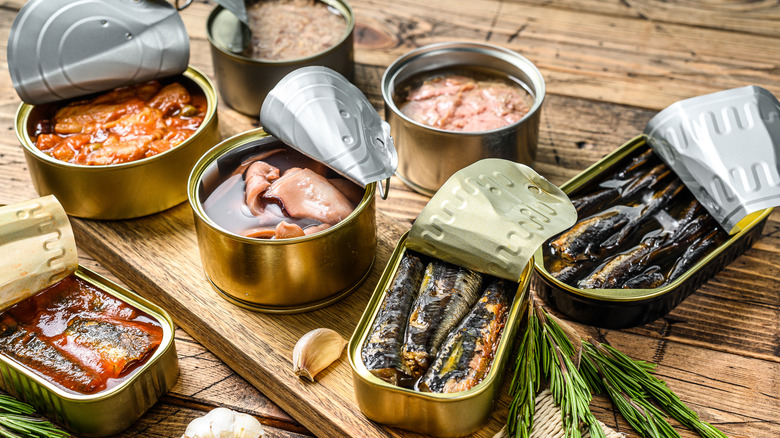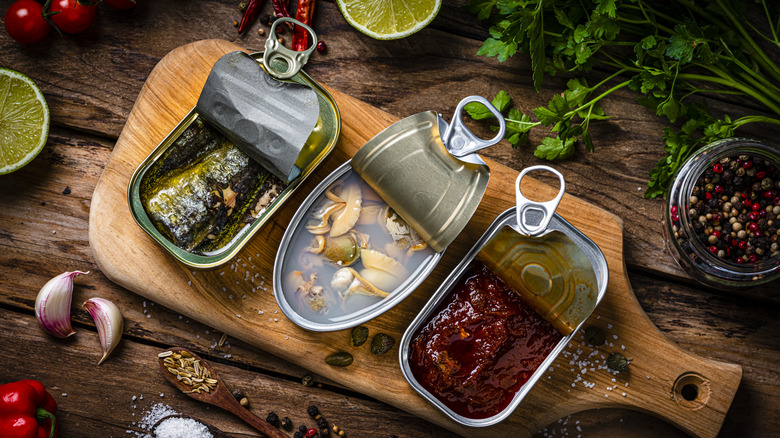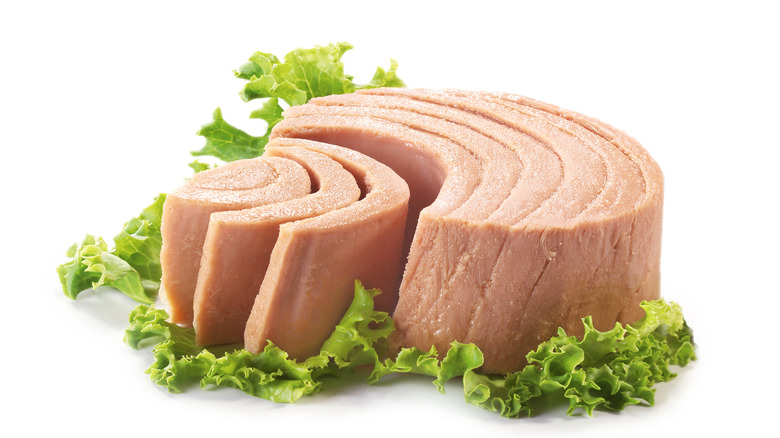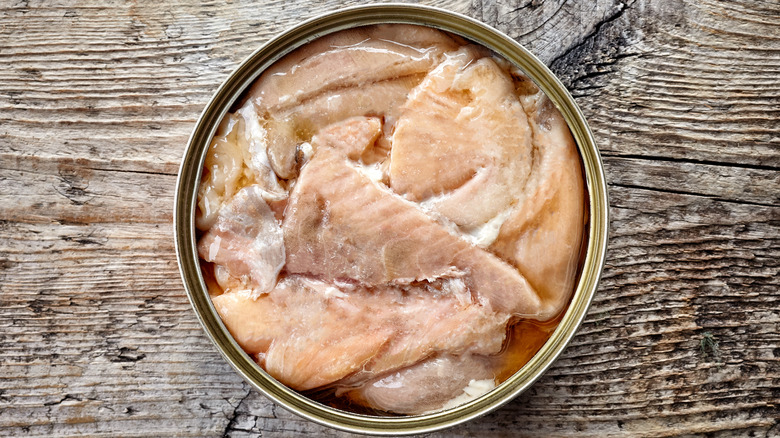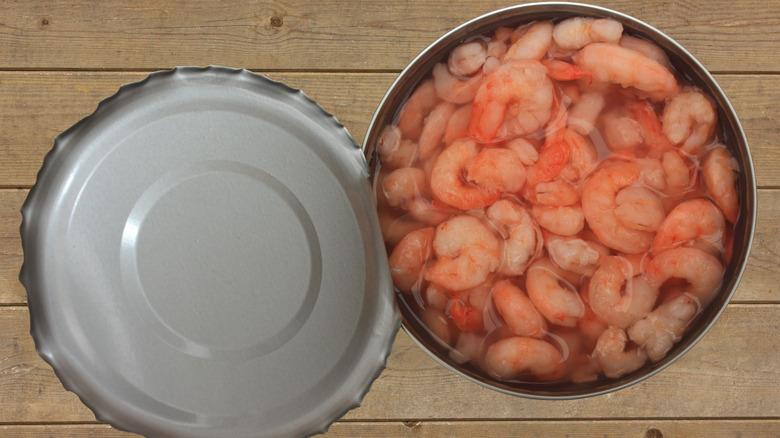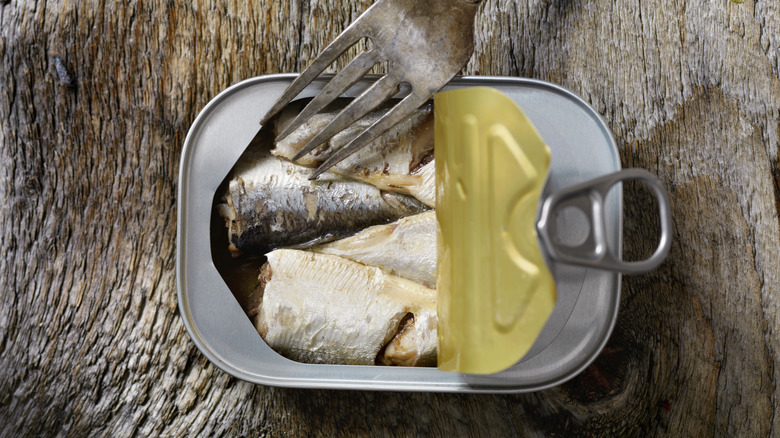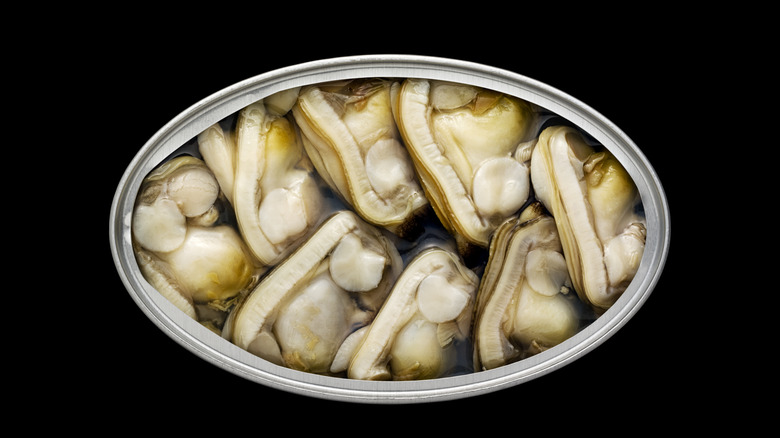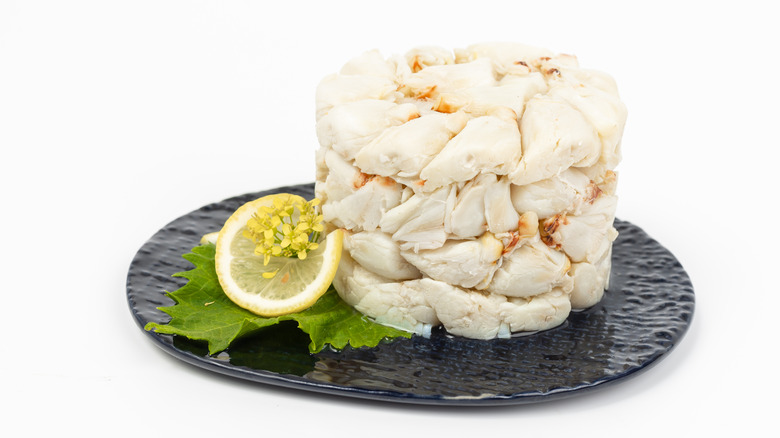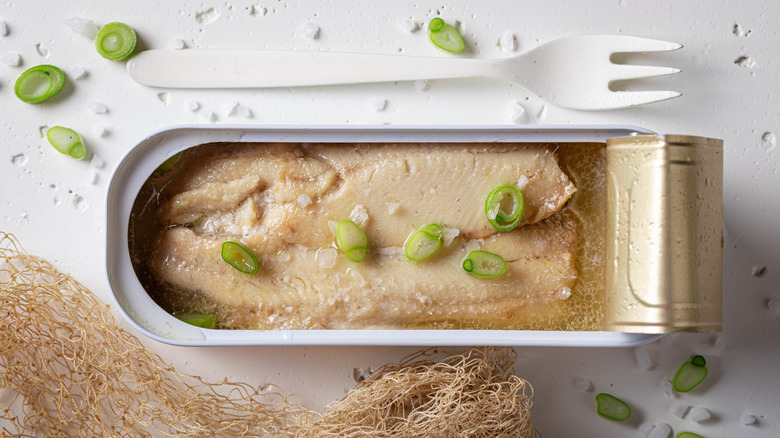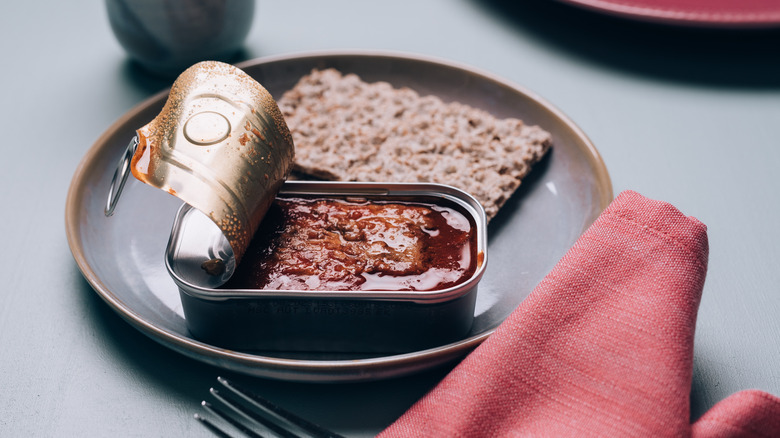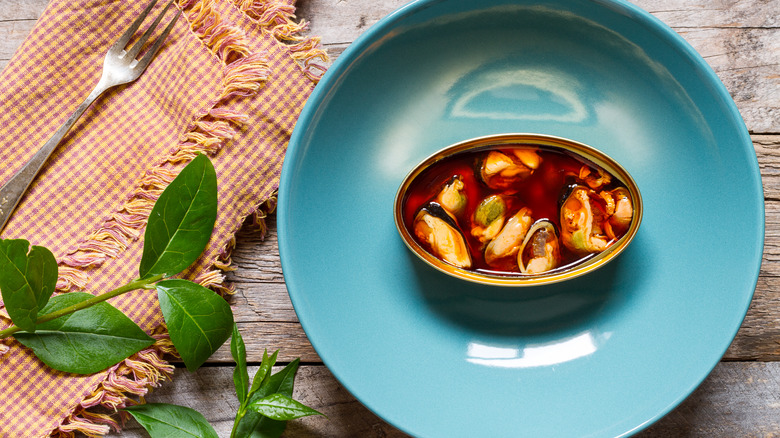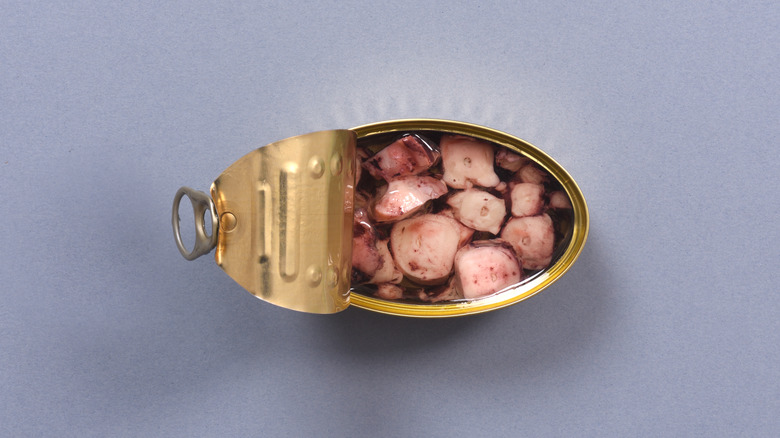The Ultimate Guide To Canned Seafood
You are surely familiar with canned tuna, arguably the most popular type of canned seafood, but did you know that this isn't your own only option? There are many different varieties of canned seafood to choose from, and this guide will explain what they are and how you can use them.
Some people may scoff at the idea of eating fish or other foods straight out of a can, but it is actually as nutritious as it is delicious. Canned seafood like tuna, mackerel, salmon, and sardines contain nutrients like omega-3 and omega-6 fatty acids, iron, iodine, vitamins B12 and D. It is also chock-full of protein, and bone-in canned fish contain calcium too. Plus, it is just darned convenient: Fresh fish and shellfish can be costly and can go bad before you can use them, but canned seafood can, in many cases, last for years in your cabinet or pantry.
Since you can keep canned seafood and use it whenever you want, you can whip up anything from seafood salads, sandwiches, or quesadillas on a whim. With some types of canned fish, you can make seafood burgers, or you can even eat them on pizza — and that's just the beginning. Let's take a deep dive into the various types of canned seafood you can find at the store and sea how you can use them in your dishes.
What is canned seafood?
First things first: What exactly is canned seafood? It is not, as one might think, just fresh fish or shrimp that has been tossed into a tin can. It is, instead, seafood that has undergone rigorous preparation to make it shelf stable. It is cleaned, then processed and sealed inside the can before being heated to very high temperatures, just like other types of canned goods. This enables it to last for months or even years longer than fresh fish.
Canned seafood is popular for many reasons. First of all, it is good for your heart thanks to those vitamins, minerals, and other nutrients we mentioned in the introduction. Omega-3 fatty acids in particular protect against heart disease thanks to their anti-inflammatory properties. These properties also make canned seafood a great addition to the diets of those with osteoarthritis, who may find some relief for this painful condition with the help of these fatty acids.
Canned seafood is also a favorite of shoppers because it is easy on the wallet. Canned seafood is typically cheaper than its fresh counterpart, and it lasts a lot longer. The FDA recommends that adults eat around 8-12 ounces of fish per week, and a smaller price tag makes this much more doable. It also helps to reduce waste: 27% of all seafood caught usually ends up being thrown away because it is not eaten in time or is improperly stored, but canned seafood helps to cut down on this waste.
Tuna
Since World War I, tuna has been the most popular form of canned seafood on the market. Sardines actually held this top spot until 1903, when there was a shortage of them and consumers were forced to switch to tuna. As it turned out, canned tuna was pretty awesome, and its popularity soared. Today, around 300 million pounds of tuna are imported into the United States from other countries every year.
There are several varieties of tuna swimming around out there in the world, but skipjack and albacore are the most popular for canning. Albacore is a bigger fish (they can weigh 60 pounds), and yields a milder, firmer meat that is perfect for sushi. It is more expensive, however, so most canned tuna is made from skipjack, a 2-10 pound fish that is much more common in nature.
While tuna contains mercury, which can be harmful when consumed in large quantities, it also contains lots of those good Omega-3 fatty acids. It's a great source of protein, too, and is low in calories and salt.
In addition to being a good addition to your diet, canned tuna is also versatile. You can make things like tuna melts or tuna salad, add it to green salads, bake it on a pizza, turn it into tuna cakes or tuna burgers, or even make pasta with it. Your possibilities are nearly endless here, so it's no surprise that almost everyone keeps a few cans in the pantry at all times!
Salmon
Some people think of fresh salmon as a "fancy" fish, meaning that it is too expensive to be a part of their regular weekly dinner menu. Canned salmon, however, is much less pricey, and can be worked into many other dishes like salmon cakes, chowders, dips, salads, or salmon croquettes. It can also be added to kid-friendly dishes like macaroni and cheese or mixed with mayonnaise to make a spread for crackers or sandwiches. You can typically find canned salmon in many different varieties, like red sockeye, chum, pink, and coho, and you can also choose between salmon with bones or without.
Salmon, like tuna, should be stored at room temperature, and can last in a cabinet or cupboard for up to three years. It is another food that is good for one's heart, as it is high in Omega-3s, which also promote brain development in small children. Unlike tuna, canned salmon may contain calcium as well, which comes from the bones of the salmon. These bones are completely edible, and also provide you with phosphorus, another beneficial mineral.
Shrimp
This one is a bit lesser-known than canned tuna or canned salmon, but we can assure you, canned shrimp is a thing — a really cool thing. It can be used to make dips, pastas, salads, or seafood omelets, but is especially popular for stuffing homemade egg rolls and spring rolls. It can be used to make sushi as well, or even as a replacement for tuna in deviled eggs.
Each 128 g serving of canned shrimp provides you with 26 grams of protein, which is 52% of the recommended daily value. It is also low in sugar and contains calcium, iron, and potassium. Certain cans can be high in sodium, however, with some containing nearly 50% of the recommended daily value. However, you can improve this by rinsing your shrimp before using it.
Like other canned seafood, canned shrimp lasts for a long time in the pantry if stored properly. While it usually tastes best if eaten within three to five years, it technically stays good even longer than that, making this one a good choice for preppers and others who want to stock up on food years in advance.
Sardines
Sardines are some of the oldest canned fish in history. In the 1830s, a man named Joseph Colin decided to come up with a way to take the idea of canned sardines and market those cans across France and, eventually, the world. By 1836, his factory was producing around 30,000 cans of sardines per year, which inspired other factories to get in on the action. By 1880, 50,000,000 cans of sardines were being sold per year, until a sudden shortage of sardines in the water led these numbers to decrease. Luckily, sardines made a comeback, but not before giving way to the rise of tuna, making sardines an underappreciated snack in modern times.
Sardines are tiny fish that can grow to around 10 inches long, and pretty much look in the can just as they did in life (just usually without the head). They are often eaten straight from the can, grilled, made into a simple sardine salad, or used as a topping for appetizers. They can come packed in oil or water like tuna, or they can come packed in tomato or other juices. Although it might sound strange, you can eat them bones, skin, and all. They are a font of calcium, iron, vitamin D and other nutrients, and can last up to three years after packaging. It's no wonder they were once on top of the canned seafood world!
Clams
Have you ever wished there was a way to enjoy clams without dealing with that pesky shell? Then canned clams were made for you! Canned clams are clams that have been shelled and chopped or minced and placed in a can that will keep them safe and tasty for up to two years past the printed expiration date. You can also find smoked clam varieties, and even clam juice in a can or a bottle, if you're into that.
While fresh clams are likely to be more tender, canned clams have a lot of benefits too. They can be eaten straight from the can, for one thing, or can be sprinkled onto salads or cooked into stews, chowders, rice dishes or pasta dishes. Canned clams are also less wasteful than their fresh counterparts, because every clam in the can has been inspected beforehand. Whereas buying clams in shells is kind of like buying a mystery grab bag and often leads to throwing out at least a few clams, you can rest assured that every clam in a can is good to eat.
Like all the other seafood on this list, clams are a good source of protein and are low in fat. You should however, check the label for the sodium level. If it's high, it's a good idea to rinse your canned clams before eating them.
Crab
Looking for a way to make crab cakes, dips, pastas, or salads without actually, you know, having to buy and prepare fresh crab? Canned crab is a great alternative to fresh thanks to its convenience and flavor. While you can eat it straight out of the can, the best way to serve canned crab is to heat it through on low heat, as this makes it temptingly tender. It is also low-carb, low-fat, and high on protein, with an average of 24 grams of protein in a 135 gram serving, making it even more tantalizing.
One thing to remember when eating canned crab is that it should always be drained before using. The process for this is just like with tuna: Open the can, then use the lid to press down as you pour out the liquid it contains. This holds the crab in and gets more of the liquid out. If there is some leftover fluid inside, you can also use a sieve.
Canned crab has a very long shelf life, lasting three to five years after the date listed on the can. It should be kept in a cool, dry place like a pantry, and any leftovers should be refrigerated and eaten within two to three days.
Anchovies
You can't write an article about canned seafood without mentioning anchovies. These tiny fish come from the Black Sea, the Atlantic Ocean, and the Mediterranean region, and are beloved for their powerful flavors. They are salty with an umami quality that makes them a savory snack or a fun topping for appetizers.
At the supermarket, you will likely see anchovies that have been preserved in oil, which should be drained before consuming. These fish are especially popular in Mediterranean and Southeast Asian cuisine, and can be used to make sauces, marinades, appetizers, and pizza toppings. You might also recognize them as a key ingredient in Caesar salad dressing.
A 57 gram serving of anchovies contains 23% of your daily recommended value of protein, as well as 41% of the selenium you need each day. They are also a source of copper, potassium, phosphorus, magnesium, calcium, and iron. They are low in carbs and contain around 3 grams of fat per serving.
Herring
Canned herring is another way to get those Omega-3 fatty acids into your diet. The most common type of canned herring is smoked, but unfortunately even this might be a bit tough to find in the United States. It is extremely popular, however, in Europe, where it is known for its versatility and its smokey taste.
If you are able to get your hands on a can of this savory smoked fish, you can treat yourself and your family to dishes like herring salad, herring pate, herring spread, herring and potatoes, herring pasta, or even herring tacos with a bit of lime. You can also use them to make herring dip, which will be a big hit at your next dinner party. You can also eat them straight from the can, as they have already been both cooked and smoked. Canned herring has a shelf life of three to five years, so if you find some, feel free to stock up!
Mackerel
There are many species of mackerel out there, but the species you are most likely to find in a can is Atlantic mackerel. These fish are appreciated for their small size, their mild flavor, and their meatiness. In addition to being high in eicosapentaenoic acid (EPA) and docosahexaenoic acid (DHA) which are both fatty acids that may reduce one's risk of cardiovascular disease, they also contain choline, which can help regulate mood, muscle control, and memory. They are high in protein too, and contain selenium, vitamin E, iron, calcium, magnesium, and more. Holy mackerel, that's a healthy fish!
But now that you know how good mackerel is for you, what should you cook with it? This underrated canned fish can work with lots of different foods, like egg dishes, sauces, curries, salad, sandwiches, and miso, with inspirations coming from all around the world. If you can't wait to eat it, you can also just grab a fork and dig right in, as it is safe to eat straight out of the can. Like most of the other seafood on this list, it will last three to five years in storage, or three to four days in the refrigerator after opening.
Mussels
Mussels are another form of shellfish that is delicious, but it can be a bit tedious to prepare them properly due to the shell, which can lead to mistakes when cooking your mussels. Canned mussels, however, are ready to eat right out of the can, and contain important nutrients like vitamin B12, iron, and iodine. They also contain selenium and riboflavin, the latter of which can give you energy and promote healthy vision and blood.
Just like fresh mussels, canned mussels can be used in pasta either as the sole source of protein or in addition to other seafood like sardines and octopus. They can also be cooked up into a paella or mixed into a salad. They can also be eaten on bread with butter, or used as a topping on crackers spread with cream cheese.
Canned mussels have a long storage life, and can come in many different liquids like olive oil, marinades, or vinegar-based sauces. There are also different varieties of mussels, like blue mussels, which tend to be smaller, and green mussels, which are larger.
Octopus
"Octopus in a can? That's outrageous!" We know it sounds a bit strange, but canned octopus is a highly underrated delicacy. This seafood is a meaty, intriguing alternative to tuna and your other more common canned fish, and it saves you the hassle of learning to cook an octopus if you want to try it and aren't already an expert.
Like fresh octopus, canned octopus can be mixed into green salads or tasty octopus and potato salads, or they can be left on their own and drizzled with lemon juice and sprinkled with mint leaves for a light summer lunch. Unlike fresh octopus, though, canned octopus is ready to eat from the can, even if a quick sauté on the stove can make it even more delectable. It is also a fantastic addition to pastas, which you can dress up with garlic, butter, capers, and wine. Octopus is low in fat and high in protein and calcium, which means that whatever you choose to make with it will be great for your body.
